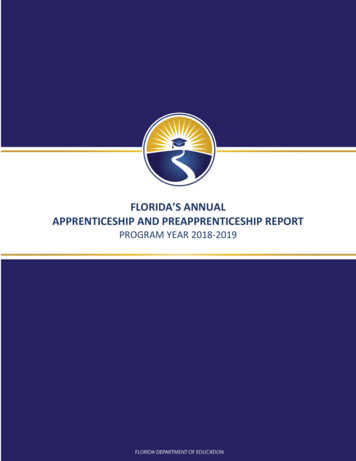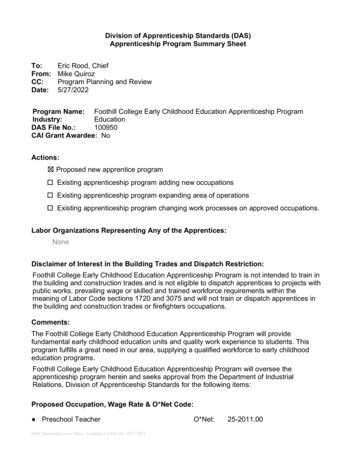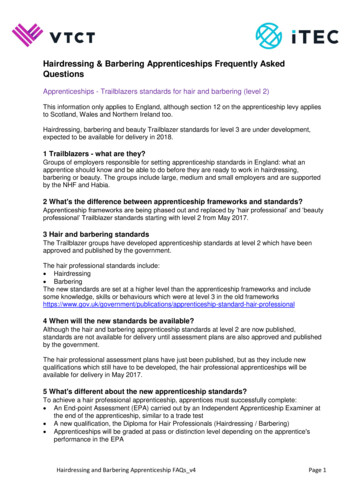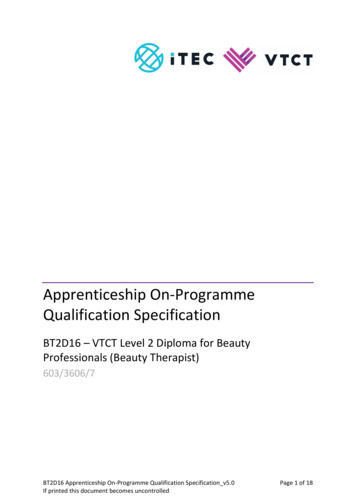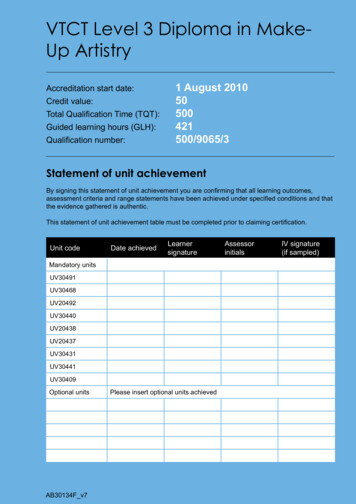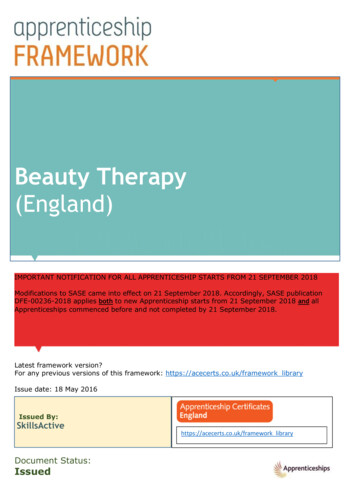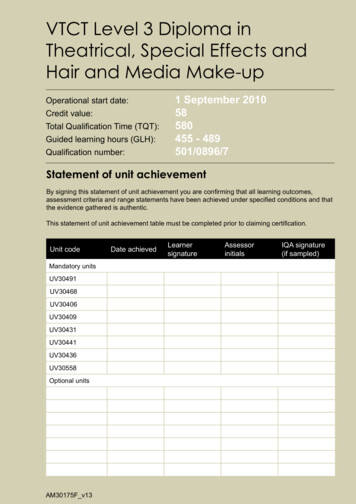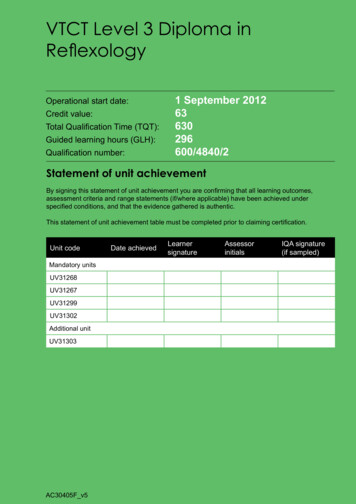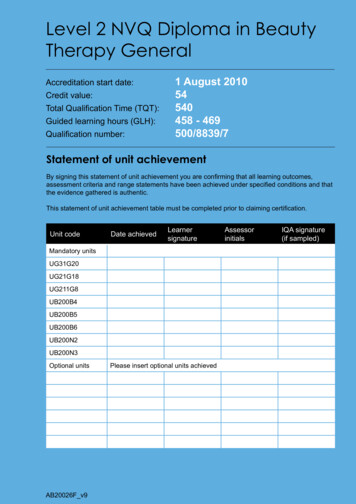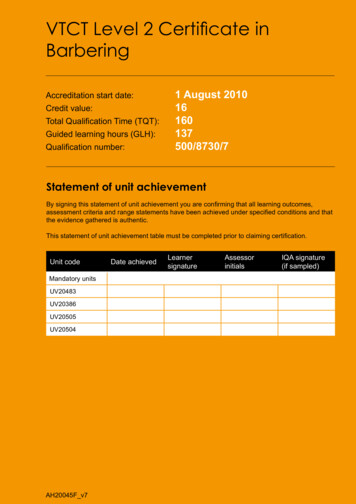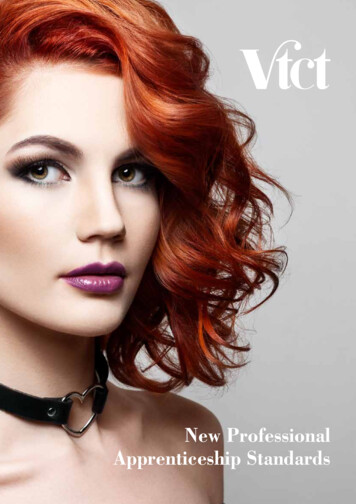
Transcription
New ProfessionalApprenticeship Standards1
What are they?A new style employer developed apprenticeship has been designed for delivery in Englandas a result of Government reforms. These new apprenticeships are known as ProfessionalApprenticeship Standards. The new apprenticeship standards will replace the old SASEFrameworks.Facts: Apprenticeship duration - between 12 months (typically for beauty) and 24 months(typically for hairdressing and barbering) Designed with employers - develops the professional knowledge, skills and behaviour requiredfor a specific job role Introduction of a new independent end-point assessment Simplified funding systemVTCT are developing 5 qualifications for the new apprenticeship standards: Level 2 Diploma for Beauty Professionals (Beauty and Spa Therapist) Level 2 Diploma for Beauty Professionals (Nail Technician) Level 2 Diploma for Beauty Professionals (Beauty and Make-up Consultant) Level 2 Diploma for Hair Professionals (Hair) Level 2 Diploma for Hair Professionals (Barbering)2
What are the differencesbetween the new standards andold apprenticeships?SASE Frameworks Funding-- Direct allocations from SFANew Professional StandardsApprenticeships Funding-- Apprenticeship levy (for employerswith a payroll bill in excess of 3million)-- Employers decide which provider-- Funding through DAS (DigitalApprenticeship Service) Programme-- Qualification-- Maths and English-- Employment Rights and Responsibilities(ERR)-- Personal Learning and Thinking Skills(PLTS) Programme-- Qualification (Hair and Beauty)-- Maths and English Assessment-- Ongoing assessment usually byprovider or employer over a periodof occasions, to record consistentperformance over a range oftreatments/services Assessment-- On programme practice to achieveconsistency of performance-- Independent external practicalexamination Gateway-- Sign-off of learners work byemployer and provider is required togain entry to end-point assessment End point assessment-- Graded (pass/distinction) by VTCT-- Conducted by a VTCT IndependentApprenticeship Examiner (IAE) Achievement and certification Achievement and certification Competent and ready to work Competent and ready to workVTCT’s new professional apprenticeship qualifications will run from 1st May 20173
4
How do they work?Three stages to the qualifications:1 PROGRAMME2 GATEWAYContinual development ofthe skills, knowledge andbehaviours required to meetthe mandatory and optionalsections of the standardand the qualification for thechosen routes.The learner must havesuccessfully completed theon-programme assessmentrequirements before takingthe end-point assessmentwhich is the final stage ofthe apprenticeship.Observations and knowldgetests to be used to assessskills, knowledge andbehaviours required for thequalification during theon-programme stage.Employer decides thetiming of the end-pointassessment, in consultationwith the Training Provider(where appropropriate)3 END POINTASSESSMENTEPA of mandatory skills,knowledge and behavioursspecified in the standard,this will be via practicalassessment and oralquestioning.The practical assessmentand oral questioning willinclude professionalism,values, behaviours,communication, safeworking practices andconsultation skills.Professionalism, behavioursand values, communicationand safe working practiceswill be embedded into thequalification andon-programme assessment.The overall grade for the apprenticeship will be determined by performance in the end pointassessment which will be graded Pass/Distinction.5
How will it be funded?For apprenticeships commencing before 1st May 2017 the funding process will remainunchanged. For the new Professional Apprenticeship Standards the funding plan applies to bothpublic and private sectors and will be based on the size of the employer.From 2017: Large employers (with a payroll bill in excess of 3million) – pay into an apprenticeship levyfrom April 2017. Employers will have control over which provider they choose and when theyspend their funding via the Digital Apprenticeship Service (DAS). Providers can then drawthose funds via their monthly ILR return Smaller employers (under 3million payroll bill, non-levy-paying) – current arrangements willcontinue to be funded through provider allocations at least until 2018 then they will receivedirect funding the same way as levy-paying employers For the new apprenticeships, from 1st May 2017 non-levy paying employers will make a10% contribution and the Government will pay 90%. Employers can choose the training, anapproved training provider and an assessment organisation using the registers available onthe DAS Every individual apprenticeship framework and standard will be allocated to a funding band.Hair professional standards have been allocated Band 9 which means funding will be cappedat 9000. The funding band for the Beauty professional standards are yet to be confirmed By 2020, all employers will be able to use the DAS to pay for training and assessment forapprenticeshipsFurther details on apprenticeship funding can be found at the following links: iceship-funding-from-may-2017 how-it-will-work ments6
How can I find out more aboutVTCT apprenticeships?VTCT are holding qualification conferences regarding the new ProfessionalApprenticeship Standards: 23rd March – MacDonald Burlington Hotel, Birmingham 27th March – MacDonald Manchester Hotel and Spa, Manchester 3rd April – Park Plaza, London VictoriaThe qualification conference will also cover Technical Qualifications at levels 2 and 3.To book please visit the VTCT website for more information:www.vtct.org.uk/Centres/Events7
8
Beauty ProfessionalApprenticeship StandardsThere are three distinctly different occupational pathways within the Beauty Professional role;each requires a different highly skilled individual practitioner to deliver the specific requirementsof each area of specialism and workplace environment; these are a Beauty and Make-upConsultant, a Beauty Therapist and a Nail Technician.All three options require the Beauty Professional to be able to carry out detailed and confidentialconsultations with clients, choosing the most appropriate services and products. They must actwith professionalism, without supervision, and observe the safe working practices associatedwith their role, to a high level of precision.A Beauty and Make-up Consultant will provide detailed make-up application andinstruction for application alongside purchasing advice in a retail environment. They willdemonstrate techniques and apply specifically chosen products to clients. They will workin a make-up studio, department store, salon or spa.A Beauty Therapist will give one to one treatments on clients in a private environmentproviding facials, hair removal waxing services, eyelash and brow treatments, hand andfoot treatments and make-up services. They will be working in a Beauty Salon or Spa.A Nail Technician will perform manicures, pedicures, nail enhancements, nailtreatments, nail art, gel polishes, nail extension and repair services using a selection ofAcrylic, Gel, Fibreglass or silk wrap systems. They will work in a Nail Bar/Salon.9
The three pathways:Route 1 – Beautyand Make-upConsultancy Mandatory units-- Instruct the use andapplication of skincareproducts and make-up-- Advise customers oneye and brow products-- Advise customers onfacial products-- Advise customers onnail products-- Contribute topromotional activities-- Follow stock controlprocedures-- Make beautyrecommendations toclients-- Advise andrecommend onperfumery products EPA duration-- Maximum 2.5 hours(excluding breaks,inclusive of a 10minute presentation)with a minimumof 1 client10Route 2 – BeautyTherapy Mandatory units-- Remove hair using wax-- Provide hand and nailtreatments-- Provide foot treatmentsRoute 3 – NailServices Mondatory units-- Provide a manicuretreatment-- Provide a pedicuretreatment-- Provide facialtreatments-- Advise customers onnail products andservices-- Provide a range of eyeand brow treatments-- Provide gel polish fornails-- Provide make-upapplication-- Create basic nail art Optional units –choose 1-- Provide self-tanning-- Provide a massage EPA duration-- Maximum 5 hours(excluding breaks) witha minimumof 1 client-- Provide a nailenhancement system EPA duration-- Maximum of 4 hours(excluding breaks) witha minimum of 2 clients
Achievement of the beauty professional apprenticeship standard will makelearners eligible for registration on a central register, held by SkillsActive(Beauty Professional Register)Duration of apprenticeship:Minimum of 12 monthsEnglish and Maths:Apprentices without Level 1 English and Maths will need to achievethis level and take the test for the Level 2 English and Maths prior tocompletion of their Apprenticeship.Entry requirements:NoneProgression to:Advanced Beauty ProfessionalLevel:2Qualification to be achieved: Level 2 Diploma for Beauty Professionals (Beauty and Spa Therapist) Level 2 Diploma for Beauty Professionals (Nail Technician) Level 2 Diploma for Beauty Professionals (Beauty and Make-upConsultant)11
12
Hair ProfessionalApprenticeship StandardsThere are two distinctly different job roles within this occupational profile: Hairdresser andBarber. Hairdressers will be able to shampoo and condition hair, cut hair using a range oftechniques, style and finish hair to create variety of looks, and colour and lighten hair forladies and men. Barbers will be able to shampoo and condition hair, cut hair using barberingtechniques, style and finish hair, cut facial hair into shape and provide shaving services for men.Hairdressers and barbers must be able to work with all hair types ranging from straight hairto very curly, wiry hair. They also need to be able to carry out consultations with clients,demonstrate the professionalism, values, behaviours, communication skills and safe workingpractices associated with their role and be able to work without supervision to a high level ofprecision, with exceptional client care skills.13
The two pathways:Route 1 - Hairdressing Mandatory units-- Consultation Mandatory units-- Consultation-- Shampoo, condition and treat the hairand scalp-- Shampoo, condition and treat the hairand scalp-- Cut hair using a range of techniques tocreate a variety of looks-- Cutting hair using barbering techniquesto create a variety of looks-- Style and finish hair using a range oftechniques to create a variety of looks-- Style and finish men’s hair-- Colour and lighten hair using a rangeof techniques Optional units – choose 1-- Perming hair-- Hair relaxing treatments andtechniques-- Hair extension services EPA duration-- Maximum 6 hours (excluding breaks)with a minimum of 2 models14Route 2 - Barbering-- Cut facial hair into shape-- Shaving services EPA duration-- Maximum of 3 hours (excluding breaks)with a minimum of 2 models
Achievement of the apprenticeship standard will make learners eligible for stateregistration with the Hair Council.Duration of apprenticeship:Typically 24 monthsEnglish and Maths:Apprentices without Level 1 English and Maths will need to achieve thislevel and take the test for the Level 2 English and Maths prior to takingthe end-point assessmentEntry requirements:NoneProgression to:Senior Hairdresser or Senior BarberLevel:2Qualification to be achieved: Level 2 Diploma for Hair Professionals (Hair) Level 2 Diploma for Hair Professionals (Barbering)15
New Professional Apprenticeship StandardsVTCT Aspire House Annealing Close Eastleigh Hampshire SO50 9PXWeb: www.vtct.org.uk Email: customersupport@vtct.org.uk Tel: 44 (0) 23 8068 4500v116
Apprenticeship Standards. The new apprenticeship standards will replace the old SASE Frameworks. Facts: Apprenticeship duration - between 12 months (typically for beauty) and 24 months (typically for hairdressing and barbering) Designed with employers - develops the professional knowledge, skills and behaviour required for a specific .
